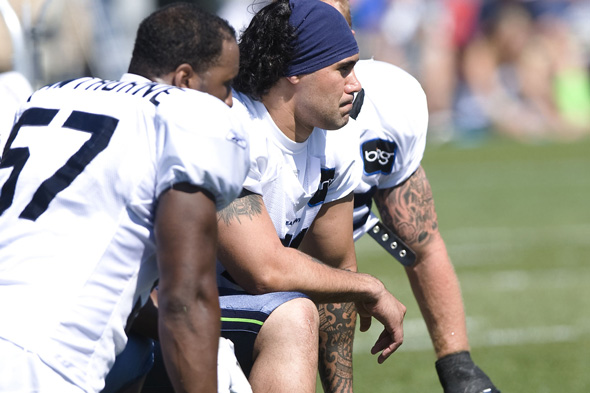
He wasnt pursued with fervor by the big colleges coming out of high school, was dismissed by nearly every pre-draft scouting service, and was ignored in the NFL draft process. But after the Seahawks signed TCU linebacker David Hawthorne as an undrafted free agent in April of 2008, Hawthorne took advantage of every opportunity. He led the Seahawks in tackles in 2009 after taking over for Lofa Tatupu, and leads the team again in 2010 in Leroy Hills old spot. With the new $1.38 million contract he signed with the team last week (keeping him in Seattle through the 2011 season), its clear that hes more than a replacement in the eyes of those who watch him play. We recently talked with Hawthorne about the journey.
Coming into the NFL as an undrafted free agent, what kind of validation is it for you that the Seahawks see your value as both an inside and outside linebacker with this new contract?
DH: I guess it just shows that hard work does pay off. I obviously took the hard route, coming in undrafted, and I never really thought about it. I just came in, jumped off the boat, and just started working. I think Im just starting to be rewarded for it now.
Why do you think you were overlooked coming out of TCU?
DH: I dont know maybe I wasnt typical in size and speed, or whatever they judge. I wasnt really recruited (coming out of high school), so I didnt have my hopes up as far as being drafted high or anything like that. I always had the hard-hat mentality; that wherever I was going to go, I was going to work and see where it took me.
Did you play all over the place in college, too?
DH: Yeah. In college, I started as a freshman, and played both positions (inside and outside linebacker) all the way through. I just kind of made plays.
When Lofa got hurt last year, missing 11 games and throwing you into the limelight at that position, what was the biggest adjustment? The middle linebacker is obviously the epicenter of the defense; what challenges did that present?
DH: Lofa is a leader, and all the guys looked to him as bring the leader of the defense. So, I had to gain the trust of a lot of people, and get the older guys to rally behind me as the MIKE (middle linebacker). I had to come out and play and prepare well, to gain the trust of my peers. I think that was the hardest thing.
Besides performance on the field, how do you gain that trust?
DH: Youve just got to study. You have to make people feel confident that you know that youre doing, and that you can lead them in the right direction. Through Lofa and a whole bunch of the other guys, I gained that trust, and it became easier for me.
What did the Seahawks tell you about your play and what they liked when they signed you out of school?
DH: Im not really sure I just think they liked my work ethic. I came to then in that first little OTA minicamp, and I just worked, you know? I didnt count the numbers, I didnt count the odds I didnt do any of that stuff. I just played like I knew how to play, and they liked it.
Were you invited to the Combine?
DH: No, I wasnt.
How did you do at your Pro Day, considering that it was the one place everyone could see you?
DH: I did pretty good for a backer. I had some of the top times in the nation one of the highest vertical jumps in the nation stuff like that. I got a lot of phone calls based on the Pro Day got invited to work out for the Dallas Cowboys, and a few other teams. I chose Seattle because I liked the atmosphere, and (running backs) coach (Kasey) Dunn, who coached at TCU back in the day, I liked the relationship I had with him.
Whats it been like moving to the weak side this season?
DH: Its been a learning process. I feel like every time I go out there at the WILL (weak-side linebacker) position, I get as comfortable out there as I am at the MIKE. I guess the first thing to do was to gain confidence in that position, and the second thing was just to get the different reads from that perspective. Ive always been more sideline-to-sideline; at WILL, its more backside (contain) and coverage and stuff like that. So, it took a little adjustment, but I think Im getting it.
What is the main different between the defense this year and the defense last year? Same defensive coordinator in Gus Bradley, but maybe coach Carroll adds a different perspective?
DH: I think the main difference is the front. We have a totally different front
Yeah, you guys are running all kinds of multiple fronts out there
DH: with a totally different mentality. Last year, we played more like the Tampa-2; the traditional 4-3. This year, its more like a base under (front), with some two-gap really utilizing the line and their stunts.
Are you a static defender in something like that, or are you all over the place as well?
DH: Im pretty much stationary in all that base under. Im covered up by the three-technique, and pretty much trying to plan off of him.
Note: for an absolutely awesome look at the 4-3 under defense Pete Carroll ran at USC (including Carrolls own explanation of it), check out this page from the brilliant Trojan Football Analysis website.

